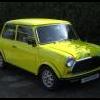
Which Antifreeze Should I Use?
#1

Posted 25 January 2008 - 06:36 PM
#2

Posted 25 January 2008 - 06:43 PM
Im a little confused as to what Antifreeze i should be using? The service history has a supplement added stating that my car should have either "Havoline XLC" or "Havoline AFC or BASFG48" One is a pinky orange colour,the other is a blue/green colour. It also says that no Antifreezes that contain Methanol or Phosphate corrosion inhibitors must be used.Whats everybody else using nowdays as im getting a bit baffled with Chemistry!! >
It depends what year your car is?
Do you know what colour antifreeze your car has in it?
Blue antifreeze is what should be used in older cars and has a 10 year lifespan, pink antifreeze is used in newer cars and has a 5 year lifespan.
I think it's from about 1999/2000 they started using pink.
Never mix antifreeze eg if you mix pink & blue it goes into a slime and cloggs everything up.
People like renault have their own yellow antifreeze and rover used to use a yellowy green antifreeze on certain cars.
Edited by mini_turbo_pete, 25 January 2008 - 06:44 PM.
#3

Posted 25 January 2008 - 07:22 PM
I normally end up changing the fluid anyway (via various repair work).
#4

Posted 25 January 2008 - 07:43 PM
#5

Posted 25 January 2008 - 10:32 PM
Im a little confused as to what Antifreeze i should be using? The service history has a supplement added stating that my car should have either "Havoline XLC" or "Havoline AFC or BASFG48" One is a pinky orange colour,the other is a blue/green colour. It also says that no Antifreezes that contain Methanol or Phosphate corrosion inhibitors must be used.Whats everybody else using nowdays as im getting a bit baffled with Chemistry!! >
Never mix antifreeze eg if you mix pink & blue it goes into a slime and cloggs everything up.
Colour can only be used as a guideline. I have never heard of mixing antifreeze causing slime and it sounds like an old wives tale to me, but I'm happy to be educatated! The main problem with mixing AF types is the reduction in corrosision resistance.
The following article may be of interest:
Until recently, the color of the most commonly used antifreezes for both light duty
and heavy-duty engine cooling systems was predominately green. Its change
interval is normally about every two years or 30,000 miles (50,000 km) of use.
Then, long life (LLC) / extended life (ELC) coolant / antifreeze was introduced in
an effort to reduce maintenance costs, downtime and environmental disposal
costs and issues. With the introduction of this totally new concept, antifreeze
manufacturers wanted to differentiate this new product from existing antifreezes.
To accomplish this, they introduced different colored dyes for their LLC / ELC
products. Orange and red dyes were used first; now it appears there may be
virtually no limit to the different dye colors that may be used.
Antifreeze is used in cooling systems to both lower the freeze point of water and
raise its boiling point. It is also used as a carrier for different types of additives
such as sodium silicate to protect aluminum from corrosion, anti-foaming agents
and other corrosion inhibitors. Although straight antifreeze actually freezes and
boils quicker than tap water, when mixed with water in the proper proportions (a
50% / 50% mix is ideal) in a cooling system, it greatly increases the cooling
system's ability to perform its designed function of removing heat from critical
engine parts and to enhance the service life of the various cooling system
components.
Inorganic Acid Technology (IAT) is the chemical composition for the traditional
antifreezes that are green in color. An IAT can be used with either ethylene glycol
(EG) or propylene glycol (PG). The normal IAT service life is two years or 30,000
miles (50,000 km).
Organic Acid Technology (OAT) was the first LLC / ELC introduced in North
America in 1994. OAT antifreeze had been widely used in Europe before its
introduction in North America. OAT can be either EG or PG but is mostly EG
based. Its first dye colors were orange and red. These dye colors are still used by
General Motors and Caterpillar. Green, pink and blue have been added to the list
of available OAT antifreezes. It is recommended that OAT not be mixed with any
other antifreeze technology. The normal OAT antifreeze service life is 5 years or
150,000 miles (250,000 km).
Hybrid Organic Acid Technology (HOAT) is a combination of IAT and OAT with
nitrites added. This makes HOAT suitable for use in both light duty and heavy
duty systems. Currently, two manufacturers are using HOAT for their vehicles.
Daimler/Chrysler's version is dyed orange and contains 10% recycled antifreeze.
Ford Motor Company’s version is dyed yellow and does not contain any recycled
antifreeze. Both of these HOAT antifreezes use the marketing designator of GO-
5. They are compatible with each other but mixing them with IAT or OAT is not
recommended. The normal HOAT antifreeze service life is 5 years or 150,000
miles (250,000 km).
Nitrated Organic Acid Technology (NOAT) is an OAT with nitrates added. This
makes NOAT also suitable for use in both light duty and heavy duty systems.
NOAT and HOAT are very similar in performance characteristics. Currently, no
OEM vehicle manufacturer is using NOAT. The normal NOAT service life is 5
years or 150,000 miles (250,000 km).
Since antifreeze is clear when it is manufactured, and water is clear, dye is used
to color the antifreeze for identification and marketing purposes. The color of
antifreeze is no longer an accurate indicator as to whether it is an IAT, OAT,
HOAT or NOAT formulation. Further, some antifreeze manufacturers market a
“universal” antifreeze they say is compatible with all OAT, HOAT and NOAT
formulations. These "universal" formulas are not for use with IAT and they will not
convert an IAT to an LLC/ELC antifreeze. Mixing IAT with OAT, HOAT or NOAT
antifreezes will not damage your vehicle’s cooling system; however the mixture
will negate the long life/extended life attributes of these formulations.
In conclusion, there are currently two oranges, two reds, green, dark green,
yellow, blue, blue-green, clear and pink dye colors available. With this variety of
dye colors and more to come, the service technician’s ability to properly service
and maintain light duty and heavy duty cooling systems properly will be greatly
challenged.
1 user(s) are reading this topic
0 members, 1 guests, 0 anonymous users
















